Francesca and Henk-Jan's Backpacking Trip!
Sunday, April 4, 2010
Pol Pot's Rampage
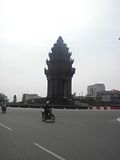
When you arrive to the Tuol Sleng Museum, it really looks like what it formerly was-- a high school—rather than the site of mass torture and killings on the scale of Nazi-massacre proportions. It has been estimated that almost 2 million people were murdered under the reign of the Khmer Rouge (that was almost a quarter of the country’s population at the time) and more than 17,000 of those murders took place at Tuol Sleng. Of those 17,000 who entered the prison, only 12 made it out with their lives. What’s even more shocking is that all of this took place over the course of just a few years from 1975 to 1979.
The Khmer Rouge took this former school (they closed all of the schools as part of their “socialist” agenda) and put prison bars on the windows, divided the classrooms with crude brick walls into cells and torture chambers, and placed layers of barbed wire over any high openings so the prisoners wouldn’t be able to commit suicide. If anyone was going to kill them, it was going to be the Khmer Rouge. And it was. Comrade Duch worked closely with Pol Pot and as a result of their extreme paranoia they had guards (usually in the teenage years) and interrogators (in their 20’s) brutally massacre innocent people.
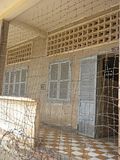
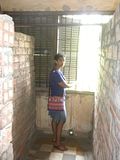
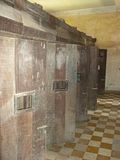
Here is a chilling summery of the torture system implemented by the Khmer Rouge from the Wiki:
“The torture system at Tuol Sleng was designed to make prisoners confess to whatever crimes they were charged with by their captors. Prisoners were routinely beaten and tortured with electric shocks, searing hot metal instruments and hanging, as well as through the use of various other devices. Some prisoners were cut with knives or suffocated with plastic bags. Other methods for generating confessions included pulling out fingernails while pouring alcohol on the wounds, holding prisoners’ heads under water, and the use of the waterboarding technique. Females were sometimes raped by the interrogators, even though sexual abuse was against DK policy. The perpetrators who were found out were executed. Although many prisoners died from this kind of abuse, killing them outright was discouraged, since the Khmer Rouge needed their confessions.”

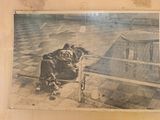
Prisoners were required to write thousands of pages of confessions and biographies summarizing everything they had done… and hadn’t done. Many of the things they confessed were completely fabricated on the hopes that they would be spared further torture. Some people made up that they were recruited by the CIA or would list out their friends or family as traitors. These false confessions would help to fuel the leaders’ paranoia, and would lead them to believe they were doing the ‘right’ thing.
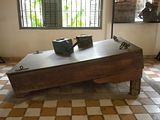
As Henk and I first made our way into the museum we saw the 14 graves of those final corpses found at the scene of the crime once the Khmer Rouge had been overthrown. Our first place to discover was “Building A” which, according to the sign, contained 3 stories divided into 20 cells. The sign told us that the first story had 10 cells used for jailing, interrogating, and torturing the prisoners who had been the high officials. The second story and third story have 5 big cells each, used for the same purpose as the first story. We entered each of the rooms the corpses were found in and saw the photographic image taken of their decomposing bodies as well as the final contents of the room -- beds the victims died on, their ankle shackles, and sometimes the devices of torture.
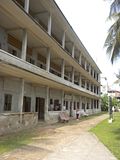
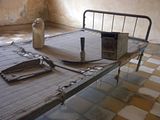
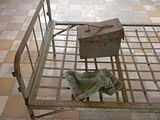
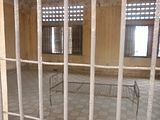
We walked past a sign while going through the above mentioned rooms which laid out the rules for prisoners. The strict rules prisoners had to obey were as follows (although Comrade Duch claims these were fabricated):
1. You must answer accordingly to my question. Don’t turn them away.
2. Don’t try to hide the facts by making pretexts this and that, you are strictly prohibited to contest me.
3. Don’t be a fool for you are a chap who dare to thwart the revolution.
4. You must immediately answer my questions without wasting time to reflect.
5. Don’t tell me either about your immoralities or the essence of the revolution.
6. While getting lashes or electrification you must not cry at all.
7. Do nothing, sit still and wait for my orders. If there is no order, keep quiet. When I ask you to do something, you must do it right away without protesting.
8. Don’t make pretext about Kampuchea Krom in order to hide your jaw of traitor.
9. If you don’t follow all the above rules, you shall get many many lashes of electric wire.
10. If you disobey any point of my regulations you shall get either ten lashes or five shocks of electric discharge.
We continued walking through the buildings (the complex ended up being much more massive than we first expected, adding to our horror by showing us just how many people were housed in the prison) until we reached the outside gallows. We saw that: “…the “gallows” was a pole with cables attached to it that had been used for the students to conduct their exercises. The Khmer Rouge utilized this place as an interrogation room. The interrogators tied both hands of the prisoners to their back with a rope and lifted the prisoner upside down. They did this until the prisoner lost consciousness. Then they dipped the prisoner’s head into a jar of smelly, filthy water, which they normally used as fertilizer for the crops in the terrace outside. By doing so, the victims quickly regained consciousness and the interrogators could continue their interrogation.”
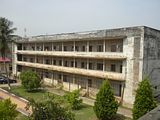
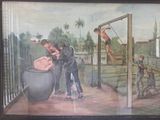
Now it was 10:00 AM and time for the documentary showing at the museum, which we were not going to miss so we put visiting the rest of the museum on hold and went to find the movie room. One of the first things the Khmer Rouge did, we learned, was to announce that the Americans were going to bomb the city of Phnom Penh (which was a lie.) This was done in order to completely empty the capital of its residents. In 5 years of civil war the population had tripled and the government targeted many of these “new people” for elimination, especially intellectuals, landowners, soldiers, and officials.
Another section of the Wiki summarizes a lot of what the documentary explained:
“The Khmer Rouge attempted to turn Cambodia into a classless society by depopulating cities and forcing the urban population ("New People") into agricultural communes. The entire population was forced to become farmers in labor camps.
Money was abolished, books were burned, teachers, merchants, and almost the entire intellectual elite of the country were murdered, to make the agricultural communism, as Pol Pot envisioned it, a reality. The planned relocation to the countryside resulted in the complete halt of almost all economic activity: even schools and hospitals were closed, as well as banks, and industrial and service companies.
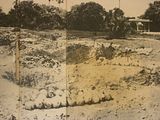
During their four years in power, the Khmer Rouge overworked and starved the population, at the same time executing selected groups who had the potential to undermine the new state (including intellectuals or even those that had stereotypical signs of learning, such as glasses) and killing many others for even breaching minor rules.
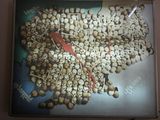
Cambodians were expected to produce three tons of rice per hectare; before the Khmer Rouge era, the average was only one ton per hectare. The Khmer Rouge forced people to work for 12 hours non-stop, without adequate rest or food. They did not believe in western medicine but instead favored traditional peasant medicine; many died as a result.
Family relationships not sanctioned by the state were also banned, and family members could be put to death for communicating with each other. In any case, family members were often relocated to different parts of the country with all postal and telephone services abolished.
The total lack of agricultural knowledge by the former city dwellers made famine inevitable. Rural dwellers were often unsympathetic or too frightened to assist them. Such acts as picking wild fruit or berries were seen as "private enterprise" for which the death penalty applied.”
Back to the museum display, we entered a room which held photographs of Heng Sinith who experienced the Pol Pot regime and wanted people to see pictures of those who committed the crimes – such as the young prison guards -- people who many view as both victims as well as perpetrators. These children were easily swayed by propaganda. Those who worked in positions of authority in the Khmer Rouge were called “Cadres” enjoyed more privileges than both the guards previously mentioned and the base people.
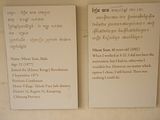
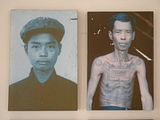
“Base People” worked for the Khmer Rouge. They were from rural areas and were forced to work in order to meet the agricultural and labor demands of the Khmer Rouge. The government would set unreasonably high quotas for products such as rice and then export the production rather than using it to feed their starving people. Most base people probably wouldn’t have survived if they weren’t able to gather their own food such as bananas and other fruit in order to get by. Yet even those made to work in the fields were not safe from the Khmer Rouge’s barbarity:
Here is the story of Lam Dararith: “When we were small, my father liked to play with us, pretending he was an elephant. He would take a big mattress, fold it in half, and put it over his head. Then he would extend his arms, sway, and come after us. He would chase anyone in the house. My parents were in Sihanoukville on the day the Khmer Rouge took over, so my brother, sisters, and I left home on April 18th. It took us almost two months to reach my mother’s village by walking on the back roads. When we arrived the first thing I saw was my father carrying a hoe. Before he had a big belly, but now he was very, very skinny. He began crying when he saw us, and said ‘I waited for you every day. I prayed for you and waited for you.’ Pretty soon, all of us were crying. He lived for two more years. We weren’t there when the Khmer Rouge took him away. Our neighbor said he was caught and they brought him to the pagoda. They accused him of wanting to escape from the village and go to see two of my brothers who were living abroad. My mother stayed home from work for ten days after that. She said to the Angkar, ‘If you want to, please, here are my four children and me. You can kill all of us.’ She was very disappointed. They took away nearly all of the people who came from Phnom Penh after that. I waited for my mom’s name to be called, but that time never came.”
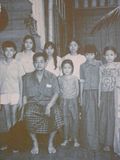
Next we saw photos taken by Gunnar Bergstrom from Sweden who came to Cambodia during the Khmer Rouge for a 14 day tour through the region. At the time he thought the movement they were starting didn’t look too bad, but reflecting back now he realizes how wrong he was to support them and regrets that he was part of their “propaganda mission” now believing that much of what he witnessed was probably staged. Along with his photos he wrote out his thoughts from 1978 and his thoughts from today of the image he photographed. Here is an example:
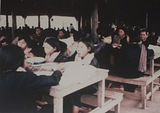
Thoughts from 1978:
‘Everybody seems to have enough food, so maybe this communal effort is a solution to distributing small resources in a fair way.’
Thoughts today:
‘This was enforced against people’s will, creating famine and poverty. The whole picture shows a militarized country whose people are treated like numbers.’
Forbidden thought at the time:
‘This looks like a military camp. Why are children separated from adults, and why are the sexes separated? Is this forced upon people?’
After enduring horrible torture at the S-21 prison, captives were then taken to the Choeung Ek extermination centre to be ‘eliminated.’ Children and babies were thought to be a dangerous threat, as they might seek revenge on those who killed their parents in the future, and thus they had to be eliminated along with their parents. In fact, it seemed as if entire family units were targeted and eliminated if just one member of the family was deemed “suspicious.” There was never any type of formal evidence that convicted any of the prisoners… they were simply considered guilty.
From the Wiki: “[In Choeung Ek] they were killed by being battered with iron bars, pickaxes, machetes and many other makeshift weapons owing to the scarcity, and subsequent price of ammunition. After the prisoners were executed, the soldiers who had accompanied them from S-21 buried them in graves that held as few as 6 and as many as 100 bodies.”
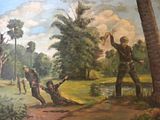
The museum also explained to us that throughout the country 19,471 mass burial pits have been discovered in 348 separate clusters. It was a mass extermination of genocidal proportions. Finally the DK fell, due to three main reasons: A weakened and overworked (or massacred) populace, purges of key members of their party due to paranoia of being overthrown from within, and mainly clashes with Vietnam. Because of the Khmer Rouge’s outrageous actions their own Cambodian people rebelled, went to Vietnam, and fought with the Vietnamese against them. This, combined with the Vietnamese’s firepower, brought down the Khmer Rouge. Only recently have the former Khmer Rouge leaders been called out for their horrendous actions years ago; in 2007 a few of them were arrested – but still so many of the perpetrators are walking freely throughout the country today.
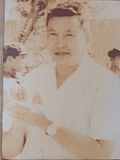
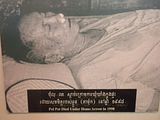
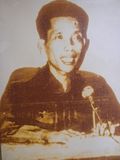
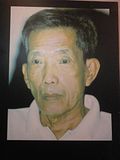
Walking around the Choeung Ek memorial site was quite an experience – there were signs everywhere labeling where mass graves had been and where various buildings for killing tools and chemicals once stood. We walked from the truck stop area where victims were dropped off to the execution pits. We saw the areas where bone fragments and teeth are still being found and the massive see-through stupa built to hold the skulls, clothing, and bones of the victims uncovered at the gravesite. One of the most shocking areas to visit was where the ‘Killing Tree’ still stands. Executioners would bash children and babies against the tree while their mothers and fathers were made to watch before they were killed alongside them.
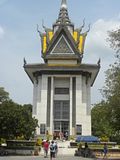
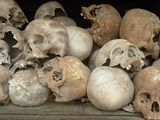
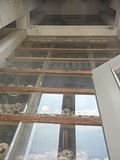
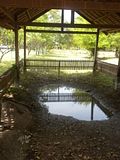
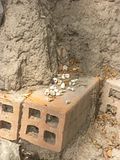
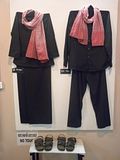
You might wonder how a government could be so cruel to its own people, and I found a few of their slogans to help answer this very question. The Khmer Rouge’s attitude towards their captives can be summarized from the following quotes about their policy:
Why they arrested everyone: “It is better to arrest ten people by mistake than to let one guilty person go free.”
Why they killed children and babies: “There is no gain to keep them, and they might take revenge on you.”
Why they murdered entire families: “Cleaning grasses, it shall dig its entire root off.”
After leaving the memorial, we made a quick stop at the Russian market. There wasn’t much to see however, looked like a typical market, so we had our driver drop us off back at the hotel. (We did make another quick stop trying to find a doctor here in Cambodia because I wanted to make an appointment with a specialist… but just as a warning to anyone on their way here – it is nearly impossible! We’re going to try again in Vietnam.) Such a long and taxing day!! For dinner we picked up some food from next door and caught up on some of our TV series back in the room. Oh, sweet
AC!

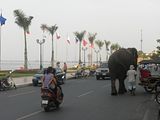
Francesca

2 Comments:
Dear Francesca,
What a dreadful tale!! people??? what kind of people, do such things?? animals are it. You dit not complete sad after result?
You want to a specialist? I do not hope it is serious??
x
Gina
Lieve Kids. Wat weer interessante verhalen. Over die Rode Khmer, dat is toch erg.Wat doen mensen elkaar toch aan. Verschrikkelijk. En die foto,s, spreken voor zichzelf.Wat ik zo knap vind van jullie is, hoe krijg je die verhalen allemaal zo mooi opgeschreven. Mooi hoor.Ga zo door, Heel veel liefs Oma.
Post a Comment
<< Home